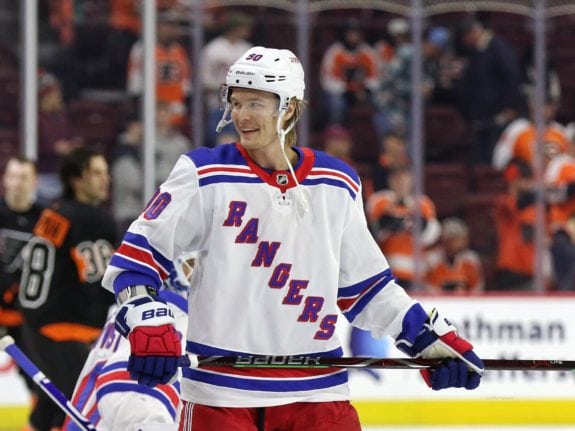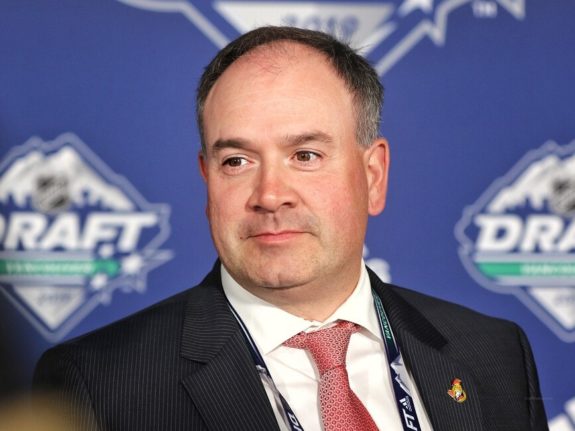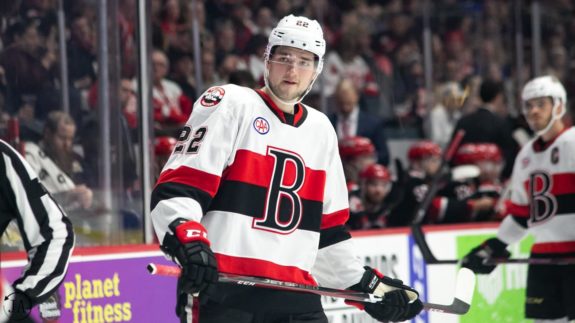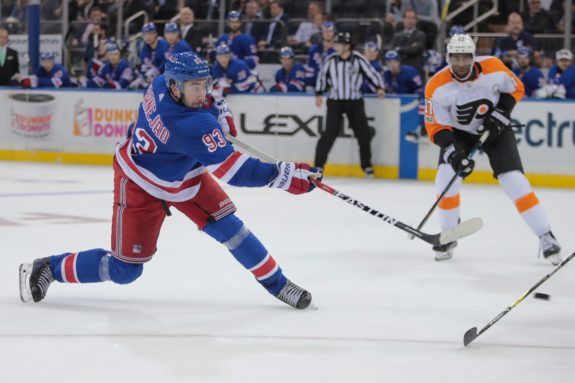There’s little denying the Vladislav Namestnikov trade is a good one. Just mainly for the New York Rangers instead of the Ottawa Senators, though.
Of course, the deal isn’t horrible for the Senators, either. It’s just not the “win” it appears to be at first glance. Whenever you acquire a middle-six guy like Namestnikov for a mid-round draft pick, it’s a decent deal. However, for a team like the Senators, who might more likely have aspirations of earning a lottery pick than contending for a playoff spot, you have to question general manager Pierre Dorion’s wisdom here.
Senators vs. Rangers
The official party line is Namestnikov is a stop-gap measure. By taking up a roster spot, Namestnikov lets the Senators develop their prospects more in the American Hockey League. Seeing as he’s an impending free agent, Namestnikov theoretically also doubles as bait ahead of the trade deadline. So, there’s at least a chance the Senators will be able to recoup the 2021 fourth-round pick they gave up to get him (along with depth-defenseman Nick Ebert).

If that ends up being the case, it’s obviously a win-win, through and through. The Rangers drop Namestnikov’s salary (retaining just $750,000 of his $4 million cap hit) and potentially open up a spot for an NHL-ready prospect in the top nine. The Senators, for their part, get to shelter an additional prospect from what is going to most certainly be a losing season. That’s the argument, anyway.
However, it’s difficult to look at the Rangers and then the Senators, two teams who should be similarly rebuilding. You have to wonder how the Rangers, who, just a year and a half ago, made their desire to rebuild public through an open letter to fans, are looking to shed an unwanted roster player to make room for additional NHL-ready prospects. Magically, they are also ready to compete for a playoff spot this season.
Meanwhile, as recently as 2016-17, the Senators had reached the third round. That was the season before the Rangers officially began rebuilding. In sharp contrast to the Rangers, the Senators are looking to hold back prospects who supposedly aren’t ready yet in spite of a “The Kids Are Alright” tagline cooked up for this 2018-19 season.
You might want to argue that’s because the two teams are in drastically different stages of their rebuilds, because they didn’t start at the same time. However, nothing could be further from the truth. The Senators actually beat the Rangers in the second round that 2017 postseason. They then fell harder than the Rangers the following campaign, accumulating 67 points to the Rangers’ 77.
On Dorion’s Watch
Keep in mind, this was all on Dorion’s watch. He had just been promoted to GM when the Sens came within a game of reaching the Stanley Cup Final. He was also GM when they fell from grace. He was also GM through the widely panned Matt Duchene, Mika Zibanejad and Erik Karlsson deals. He was also with the team as a scout a lifetime ago and has to shoulder some blame for the questionable drafting that has gone down, while he has been GM. That’s doubly true if it’s actually the team’s development of prospects, like Logan Brown, that is to blame.

Although predecessor Bryan Murray had served in a senior advisory role at the time, Dorion was GM at the 2016 NHL Entry Draft when he made Brown his first-ever draft pick. At the time, Brown was seen as a can’t miss prospect (in large part due to his 6-foot-6 stature), but one with undeniable holes in his game. The issue isn’t that Dorion drafted Brown, whose father, Jeff, was head coach of the Ottawa 67’s at the time. It’s that he traded up a single spot to get him, sending an additional third-round pick to the New Jersey Devils.
Obviously, the Senators really wanted Brown. However, if you’re going to just give away picks like that, you had better make damn sure the prospect you’re acquiring is a sure thing. Brown wasn’t. Granted, he can still make it. He’s still just 21 years old, but it is telling that third-rounder, Joey Anderson, has played more NHL games than Brown’s six up to this point. So have 11 players picked after him in that first round, including Michael McLeod, who the Devils drafted with the Senators’ original pick.

Maybe it pays to stay patient with regard to Brown’s development. The reality is acquiring Namestnikov doesn’t really move the needle all that much. It may not even move it in the right direction when all is said and done. While a fourth-round pick admittedly isn’t the be-all and end-all, it is a potential Drake Batherson (2017), Christian Wolanin (2015), Jean-Gabriel Pageau (2011), or even Ray Emery (2001).
Namestnikov a Temporary Solution?
The fact of the matter is, if you want to keep your prospects in the minors to develop further, you don’t need Namestnikov to do it. There were other avenues to pursue, like free agency with an inexpensive Patrick Marleau available up to just recently. Jason Pominville is still up for grabs, too. And, if you’re banking on parlaying Namestnikov into a higher draft pick come the trade deadline, there’s just as good of a chance that you won’t be able to, because Namestnikov is far from guaranteed to produce in a top-six role.
There’s really only been one stretch in Namestnikov’s career during which he produced like an offensive forward. That was immediately prior to his acquisition in 2018 by the Rangers, when he was still with the Tampa Bay Lightning and getting regular ice time with Steven Stamkos and Nikita Kucherov. Even then, he was limited to just 44 points in 62 games, which isn’t bad, but it’s certainly nothing on which to hang your hat. Case in point, after being traded to the Rangers, where he got more ice time than the likes of Chris Kreider and Pavel Buchevich, he managed just four points over the last 19 games of the season.
Last season was better for Namestnikov. He ended with 31 points, which, judging from his career up to now, seems like a good assessment of what he’s capable of delivering year-in, year-out. However, that’s on the Lightning, where he was routinely a 30-point guy. Without an adequate supporting cast on the Senators, set to play with Artem Anisimov and Connor Brown, Namestnikov may very well see his production drop further. If that’s the case, recouping that fourth-round pick may prove difficult.
Brown vs. Zibanejad
To put it in perspective, the Namestnikov acquisition won’t make or break the Senators on its own, that’s for sure. He is a decent two-way player, but he’s also 27 and a pending unrestricted free agent, who is unlikely to play a critical role in the team’s future past this season. Suffice it to say, Logan Brown has more of a chance to do that, even if the kid gloves are on him to a certain extent.

You can cite Zibanejad as an example if you want, about how he was rushed and inconsistent, but it really comes across as more of another argument that the Rangers know what they’re doing and the Senators not so much. By the time he was traded for Derick Brassard, Zibanejad was still a 50-point 23-year-old. Brassard’s best years were behind him. It was another mistake by Dorion. If you’re arguing holding Brown back is justified because Zibanejad didn’t come along fast enough, spoiler alert: He turned out okay. So did the early Senators, as they started gaining traction as a powerhouse at the turn of the century.
Consider the core of the 2001-02 team that reached the second round, excluding a 28-year-old Daniel Alfredsson: Radek Bonk, Marian Hossa, Martin Havlat, Wade Redden, Zdeno Chara and Chris Phillips: All 25 years or younger at that stage. For the most part, they played several years together prior to that point. Namestnikov likely won’t be here for years, though.
So, if the party line is Namestnikov was acquired as it’s best to hold back some of the team’s younger players and shelter them from a losing season, that’s not necessarily true. Seeing as six Senators on the roster right now are 22 or younger, Dorion may not actually believe it either. This was a hockey trade pure and simple, just a pointless one for the Senators. It won’t break them, but it won’t help them as they continue to rebuild, either. You’d think Dorion would have a good idea of what would by now, even if it’s by process of elimination.